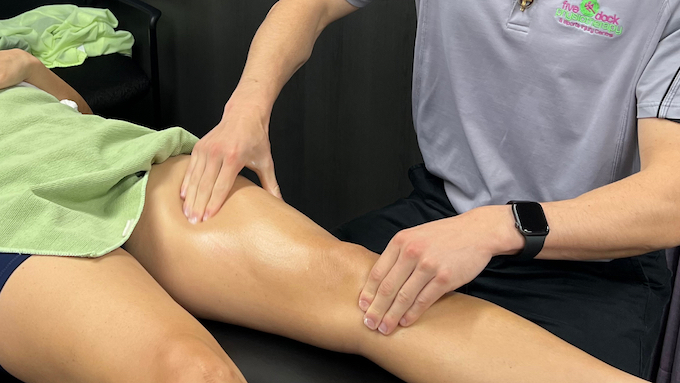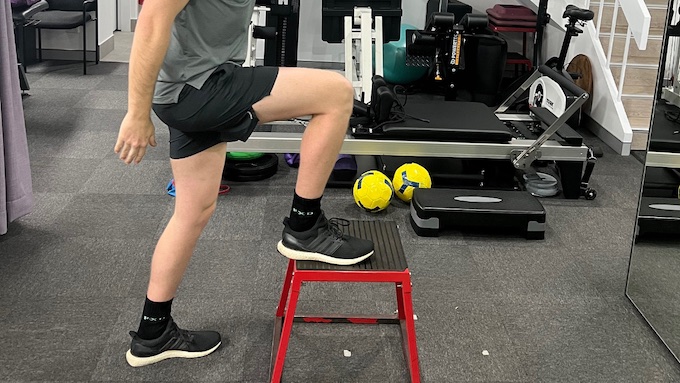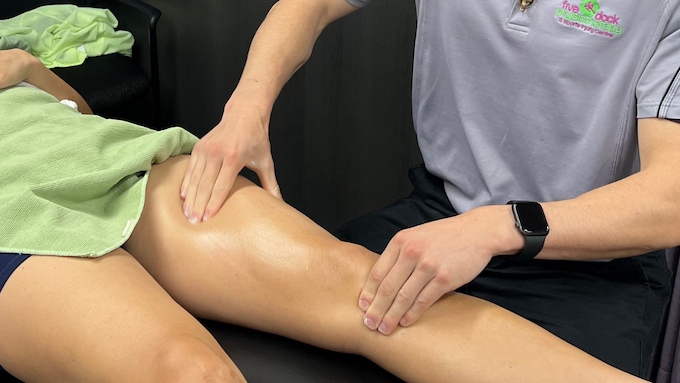Your Quadricep Muscles are a group of muscles at the front of your thigh. Primarily these 4 muscles as a group extend your knee and ensure that your patella tracks correctly.
The rectus femoris is the most superficial of the quadriceps muscles alongside the vastus lateralis, vastus intermedius, and vastus medialis. Although a powerful knee extensor, the rectus femoris is also a strong hip flexor as it is the only 2 joint muscle of the quads group arising from the iliac crest and attaching to the tibia.
Together, these 4 muscles contain more mass than any other muscle group in your body. You use your quads to perform a variety of movements, including kicking, running, jumping and walking.
The anatomy of these muscles plays an important role in muscle prognosis. Rectus femoris is a fusiform and biarticular muscle, designed to execute movements that require length change or high shortening velocity. Rectus Femoris has a high demand for eccentric muscle contraction and a high percentage of type II fibres (~65%), making it more prone to injury.
In acute quadricep muscle injuries sustained during sport, the athlete feels a tearing sensation and stops playing. In subacute injuries the player reports gradual onset of pain during running and kicking. Examination reveals that stretching, palpation at the site of injury and resisted knee extension are painful. In Rectus femoris tears resisted hip flexion also may elicit symptoms.
Risk Factors
- Previous quadricep injury particularly within the past 8 weeks
- Previous knee injury or pubic bone stress
- Kicking sports e.g. AFL, soccer, ballet
- Age (AFL players > 23 years of age – Orchard et al., 2013)
- Reduced hip range of motion and quadricep muscle length
- Muscle fatigue (80% of injuries occur towards the end of a match)
- Poor Muscle activation patterns or weakness (weak core, calf and/or gluteal muscles)

Mechanisms of injury (2 Factors)
1. Sprinting Injury Mechanisms:
– Acceleration
– Deceleration
2. Kicking Injury Mechanisms:
– Ball Contact
– Swing Phase
– Ground Contact Phase
Diagnosis / Assessment
- Asymmetry in muscle bulk between limbs
- Tenderness, and often swelling, bruising, warmth and pain on palpation of a quadricep muscle – in more severe injuries, there may be a lump or a gap in the muscle bulk, which can indicate a higher grade tear
- Increased quadricep tension and pain or increased discomfort when the muscle is stretched
- Decreased knee extension/flexion range of movement and hip flexion range when the leg is straight or bent
- Pain on specific muscle testing (Resisted hip flexion & knee extension)
- As always examination of biomechanics and diagnosing why this injury has occurred is critical – was it simply too much load, or are there other muscles not activating well leading to too much stress through the quadriceps causing the tear.

“The rectus femoris (RF) is the most commonly injured muscle of the quadriceps muscle. Quadriceps muscle injuries cause more missed games than do hamstring and groin muscle injuries and reinjury rates (17%) are high.
Treatment and Evidence
After diagnosing the injury, and appropriately grading the severity of the tear to give a prognosis, initial stages of treatment aim to reduce pain, inflammation, manage scar tissue and prevent further injury. Crutches may be necessary for patients that are unable to weight bear. They should only be used for short periods of time as early mobilisation allows muscle fibres to regenerate and organise more effectively (Jarvinen TA et al. 2005).
Scar tissue can start begin to form within 2 days of the tear and thus physiotherapy can commence. In the early stages of rehabilitation as symptoms improve it is important to restore normal walking patterns to avoid developing compensations. Our physiotherapists will help our patients activate and use the correct muscles with exercises and gait retraining. Incorporating an exercise program to improve range of motion, flexibility, strength, endurance and motor control is essential for recovery and should be implemented once symptoms allow. Gentle stretching is important to lengthen the muscle, improving elasticity and distending the scar tissue appropriately (Jarvinen et al 2005). Ice is useful in the acute stage and patients will often benefit from the use of Tubigrip compression to support the injury site.

Within 10 days of the injury, scar tissue that has formed over the tear will have the same tensile strength as normal muscle and gradual loading can begin (Dixon et al 2009). Strengthening exercises will be provided for the muscles in the thigh and will progress in difficulty until the injured leg’s strength and endurance is comparable to the non-injured leg. Brukner and Khan recommend addressing biomechanical factors that preceded the injury such as muscle tightness, lumbopelvic dysfunction or knee/ankle related abnormalities.

How Does Physiotherapy Help?
As with any musculoskeletal injury, prevention is far superior to treatment, and physiotherapy is heavily involved in both of these phases. A pre-season screening can highlight any strength or length impairments or imbalances in the quadricep muscle group/kinetic chain through specific testing. This screening can also assess biomechanical factors including weakness in other muscle groups that may lead to increased loading through and eventual failure of the quadricep muscles. Once assessed our physiotherapists can then implement an appropriate exercise program and running/sprint program focused on injury prevention.
Once a quadricep tear does occur (regardless of the severity), early physiotherapy is crucial to achieve an optimal outcome and safe return to pre-injury function. Our staff will assess the severity of the quadricep injury, implement acute management strategies and recommend an appropriate treatment plan based on the patient’s goals and the extent of the damage. Treatment will focus on facilitating muscle healing through manual therapy, and include the prescription of a progressive exercise program including eccentric, concentric and neuromuscular strengthening, stretches and sport based functional exercises. An end stage running program will be included to ensure graduated return to sports involving agility, prolonged running and a graduated sprinting program. Any biomechanical deficits will also be addressed prior to return to sport or specific high level tasks. A safe discharge and full recovery is based on objective measures to ensure that muscle strength imbalances, technique and biomechanics are corrected to reduce the likelihood of re-injury. We use our AxIT dynamometers and force plates in clinic to assess strength and muscle endurance to ensure that these imbalances are addressed. Other useful markers and the ability to hop and jump, and perform vertical and horizontal jumping equal to the unaffected leg. Often a gym program will be designed for the recovering patient that they can continue with once discharged to help prevent further injuries arising.


